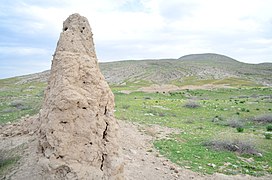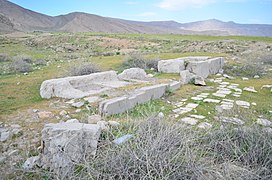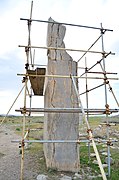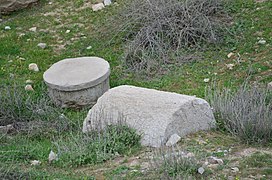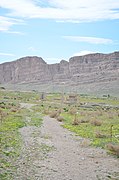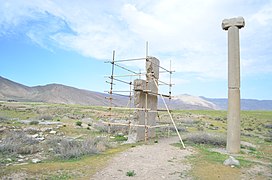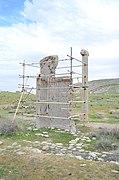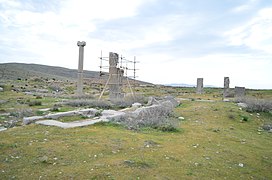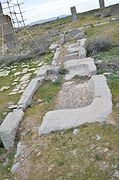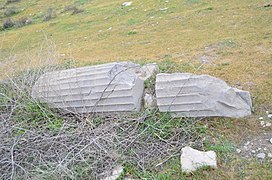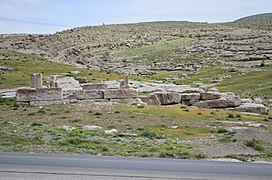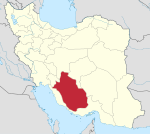Istakhr
| |
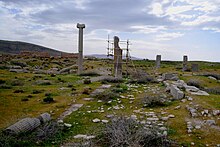 Columnsat Istakhr | |
| Region | Fars Province |
|---|---|
| Coordinates | 29°58′51″N52°54′34″E/ 29.98083°N 52.90944°E |
| Type | Settlement |
| History | |
| Founded | Very shortly after the decline ofPersepolis(second half of the 4th century BC) |
| Periods | Classical antiquitytoLate Middle Ages |
Istakhr(Middle Persianromanized:Stakhr,Persian:استخر,romanized:Estakhr) was an ancient city inFars province,five kilometres (three miles) north ofPersepolisin southwesternIran.It flourished as the capital of the PersianFratarakagovernors andKings of Persisfrom the third century BC to the early 3rd century AD. It reached its apex under theSasanian Empire(224-651 AD), and was the hometown of theSasanian dynasty.Istakhr briefly served as the first capital of the Sasanian Empire from 224 to 226 AD and then as principal city, region, and religious centre of the Sasanian province ofPars.
During theArab conquest of Iran,Istakhr was noted for its stiff resistance, which resulted in the death of many of its inhabitants.[1][2]Istakhr remained a stronghold ofZoroastrianismlong after the conquests, and remained relatively important in the early Islamic era. It went into gradual decline after the founding of nearbyShiraz,before being destroyed and abandoned under theBuyids.Cursorily explored byErnst Herzfeldand a team from theUniversity of Chicagoin the first half of the 20th century, much of Sasanian Istakhr remains unexcavated.
Etymology
[edit]"Istakhr" (also spelledEstakhr) is theNew Persianform of theMiddle PersianStakhr(also spelledStaxr), and is believed to mean "strong(hold)".[1]According to theIranologistErnst Herzfeld,who based his arguments on coins of the PersianFratarakagovernors andKings of Persis,the Middle Persian word in turn derives fromOld Persian*Parsa-staxra( "stronghold of Pars" ), owing to the city's close connections with the nearbyPersepolisplatform.[1][a]Herzfeld interpreted theAramaiccharacters "PR BR" inscribed on these coins as an abbreviation of Aramaicprsʾ byrtʾ( "the Fortress of Parsa" ), which in turn may be the equivalent of the aforementioned Old Persian words.[1]The abbreviation "ST", denoting Istakhr, also appears onSasanian coins.[2]Istakhr is attested inSyriacasIstahrand inArmenianasStahr.[2]It probably appears in theTalmudasIstahar.[2]
Geography
[edit]Istakhr is located in Iran's southwestern province ofFars,historically known as Parsa (Old Persian),Pars(Middle Persian) andPersis(Greek), whence Persia.[3][4]It lies in the valley of the Polvar River, between theKuh-e Rahmatand theNaqsh-e Rostam,where the Polvar River valley opens into the plain ofMarvdasht.[1]This plain stretches near the platform of Persepolis.[1]
History
[edit]
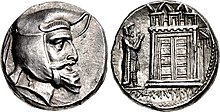
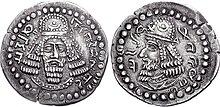


Early history
[edit]In all likelihood, what became Istakhr was originally part of the settlements which surrounded theAchaemenidroyal residences.[1]Its religious importance as aZoroastriancenter was signified as early as the 4th century BC during the reign of Achaemenid KingArtaxerxes II(r. 404-358).[5]During his reign, he ordered the construction of a statue ofAnahidand a temple near what would become Istakhr.[5]This temple may be identified with the ruins of the temple mentioned by the 10th-century geographeral-Masudias being locatedc. oneparasangfrom Istakhr.[5]According to the IranologistMary Boyce,the ruins of this temple probably belonged to the original Achaemenid building, which had been destroyed and pillaged by the invadingMacedoniansled byAlexander the Great(r. 336–323).[5]Istakhr's foundation as a separate city took place very shortly after the decline of nearbyPersepolisby Alexander. It appears that much of Persepolis' rubble was used for the building of Istakhr.[2]
Frataraka and Kings of Persis
[edit]WhenSeleucus I(r. 305–280) died in 280 BC, the localPersiansofPersisbegan to reassert their independence.[1]The center of resistance appears to have been Istakhr, which with its surrounding hills provided better protection than the nearby former Achaemenid ceremonial capital of Persepolis.[1]Furthermore, an important road, known as the "winter road", extended across Istakhr, leading from Persis toIsfahanthroughPasargadaeandAbada.[1]The core of Istakhr as a city was located on the south and east side of the Polvar River. It flourished as the capital of the PersianFratarakagovernors andKings of Persisfrom the 3rd century BC to the early 3rd century AD.[1][6]
Sasan,the eponymous ancestor of the laterSasanian dynasty,hailed from Istakhr and originally served as the warden of the importantAnahid fire-templewithin the city.[2][6][5]According to tradition, Sasan married a woman of theBazrangidynasty, who ruled in Istakhr asParthianvassals in the early 3rd century.[5]In 205/6, Sasan's sonPapakdethronedGochihr,the ruler of Istakhr.[7]In turn, Papak's sons,Shapurand Ardashir V, ruled as the last two Kings of Persis.[8]
Sasanian Empire
[edit]In 224, Ardashir V of Persis founded theSasanian Empireand became regnally known asArdashir I(r. 224–242).[2]Boyce states that the temple, which had been destroyed by the Macedonians centuries earlier, was restored under the Sasanians.[5]She adds that according to Al-Masudi, who in turn based his writings on tradition, the temple had "originally been an 'idol-temple', which was subsequently turned into a fire temple byHomay,the legendary predecessor of the Achaemenid dynasty ".[5]It appears that in the early Sasanian period, or perhaps a bit before that, the Zoroastrian iconoclastic movement had resulted in the cult-image of Anahid being replaced by a sacred fire.[5]Al-Masudi identified this sacred fire as "one of the most venerated of Zoroastrian fires". The identification of this temple at Istakhr with Anahid persisted, and the historianal-Tabari(died 923) stated that it was known as "the house of Anahid's fire".[5]
The influential Zoroastrian priestKartirwas, amongst other posts, appointed as warden (pādixšāy) of "fire(s) at Stakhr of Anahid-Ardashir and Anahid the Lady" (ādur ī anāhīd ardaxšīr ud anāhīd ī bānūg) byBahram II(r. 274–293).[5]Boyce notes that given the high-ranking status of Kartir, the appointment of these posts signify that the sacred fires at Istakhr were held in very high regard.[5]
Istakhr would reach its apex during the Sasanian era, serving as principal city, region, and religious centre of the Sasanian province ofPars.[1][6]A center of major economic activity, Istakhr hosted an important Sasanian mint, abbreviated with the initials "ST" (Staxr) which producedcoinsfrom the reign ofBahram V(r. 420-438) until the fall of the dynasty, as well as the Sasanian royal treasury (ganj ī šāhīgān).[1][6][5]This treasury is frequently mentioned in theDenkardand theMadayān i hazar dadestan.[5]The treasury also held one of the limited copies of theGreat Avesta,probably one of the very same copies from which the modern-day extant Avestan manuscript derives.[5]
Arab conquest and caliphates
[edit]During theMuslim conquest of Pars,as part of theArab conquest of Iran,the invaders first established headquarters atBeyza.[1]The citizens of Istakhr firmly resisted the Arabs.[2]The first attempt, in 640, led byAl-Ala'a Al-Hadramiwas a complete failure.[2]In 643, the Arabs conducted a new campaign led byAbu Musa al-Ash'ariandUthman ibn Abu al-Aswhich forced Istakhr to surrender.[2]The people of Istakhr, however, quickly revolted and killed theArabgovernor installed there.[2]In 648/9, GeneralAbdallah ibn Amir,governor of Basra, conducted another campaign which once again forced Istakhr to surrender after heavy fighting.[1]The suppression of subsequent revolts resulted in the death of manyPersians.[2]However, the restive people of Istakhr revolted once again, which prompted theArabsto undertake yet another campaign against Istakhr, in 649.[1]This final campaign once again resulted in the death of many of its inhabitants.[1]Istakhr's Sasanian fortress, located on theMarvdasht's "easternmost outcrop", became the location of the last resistance to the Arab conquest of Pars.[6]
Istakhr remained a stronghold ofZoroastrianismlong after the fall of the Sasanians.[1]ManyArab-Sasanian coinsand Reformed Umayyad coins were minted at Istakhr during theUmayyadandAbbasidperiods.[1]Istakhr remained "a fairly important place" in the early Islamic period.[2]It was the site of an important fortress, which in Islamic times, "as no doubt earlier", often functioned as the treasury of the rulers of the city.[1]The fortress is variously known asQal-e-ye Estakhr( "Castle of Estakhr" ) orEstakhr-Yar( "Friend of Estakhr" ).[1]Under the Umayyad Caliphate, governors often resided at the castle; for instance,Ziyad ibn Abihresided at Istakhr's castle for a lengthy period during his struggle against CaliphMuawiyah I(r. 661–680).[2]
Following the ascension of the Abbasids, the political center of Fars shifted gradually toShiraz.[1]This contributed heavily to the decline of Istakhr.[2]However, the city is still mentioned in the wars between theSaffaridsand the caliphal governors in Fars.[1]On 11 April 890, Saffarid rulerAmr ibn al-Layth(r. 879-901) defeated the Caliphal governor Musa Muflehi at Istakhr. According to the IranologistAdrian David Hugh Bivar,the last coin attributed to Istakhr is a coin supposedly minted by theDulafidsin 895/6.[1]
Buyids and Seljuqs
[edit]The area became part of theBuyidsin the first half of the 10th century. At the turn of the millennium, numerous travel writers and geographers wrote about Istakhr. In the mid-10th century, the travel writerIstakhri(himself a native), described it as a medium-sized town.[2]The geographerAl-Maqdisi,writing some thirty years later, in 985, lauded the bridge over the river at Istakhr and its "fine park".[2]He also noted the town's chief mosque was decorated with bullcapitals.According to Boyce and Streck & Miles, this mosque was originally the same Sasanian temple where theādur ī anāhīd ardaxšīr( "fire of Anahid-Ardashir" ) was located and whereYazdegerd III(r. 632–651) the last Sasanian King was crowned.[5][2]However, according to the modern art historianMatthew Canepa,archaeological evidence shows that the mosque was built in the 7th century during Arab overlordship, and was, therefore, not a converted Sasanian temple.[6]Al-Maqdisi also noted it was assumed that the mosque had originally been afire temple,in which "pieces of carving from Persepolis had been used".[2]
The region's cold climate created accumulations of snow at the top of the castle of Istakhr, which in turn melted into acisterncontained by a dam. This dam was founded by the Buyid'Adud al-Dawla(r. 949-983) to create a proper water reservoir for the castle's garrison. According to a contemporaneous source, the BuyidAbu Kalijar(r. 1024–1048) found enormous quantities of silver and costly gems stored in the castle when he ascended it with his son and a valuer.[1]The gold medal of Adud al-Dawla, dated 969/70, which depicts him wearing a Sasanian-style crown, may have been created at Istakhr.[1]
The last numismatic evidence of Istakhr, denoting its castle rather than the city itself, dates to 1063.[1]The coin in question was minted on the order of Rasultegin, an obscureSeljuqprince of Fars.[1]However, Bivar notes that some coins attributed to other areas of Fars may in fact be coins from Istakhr. According to Bivar, who bases his arguments on the writings ofIbn al-Athir,the treasury of Istakhr held the treasures of earlier dynasties. Ibn al-Athir wrote that whenSeljuqSultanAlp Arslan(r. 1063-1072) conquered the castle of Istakhr in 1066/7, its governor handed him a valuable cup inscribed with the name of the mythical Iranian kingJamshid.[1]Istakhr also held theQal-e ye Shekaste,which functioned as the city's textile store, and theQal-e ye Oshkonvan,the city's armory. Though the locations of these fortresses appear to be relatively distant from Istakhr's inner core, in the Medieval era they were "regarded as within the greater city" of Istakhr.[1]
In the closing years of the Buyid Abu Kalijar, avizierengaged in a dispute with a local landowner of Istakhr. Abu Kalijar, in turn, sent an army to Istakhr under Qutulmish who destroyed and pillaged the city.[1]Istakhr never recovered and became a village with "no more than a hundred inhabitants".[1][2]
In 1074, during Seljuq rule, a rebel namedFadluyahad gained control over the province of Fars and had entrenched himself in Istakhr's castle.[2]Nizam al-Mulk,the renowned vizier of the Seljuq Empire, subsequently besieged the fortress. Fadluya was captured and imprisoned in the fortress and executed a year later when he tried to escape.[2]In later periods, the castle was often used "as a state prison for high officials and princes".[2]
Period thereafter
[edit]Inc. 1590,the castle of Istakhr was reportedly still in good condition and inhabited.[2]Some time later, a rebelSafavidgeneral took refuge in the castle. It was subsequently besieged by SafavidShah( "King" )Abbas the Great(r. 1588–1629), resulting in the destruction of the castle.[2]According to the Italian travelerPietro della Valle,who visited Istakhr in 1621, it was in ruins.[2]
Excavation
[edit]In the first half of the 20th century, Istakhr was cursorily explored byErnst Herzfeldfollowed by a team from theUniversity of Chicagoled byErich Schmidt.[2][6]The most detailed account of the ruins of Istakhr predating the 20th century excavations was made by the French duoEugène FlandinandPascal Costein late 1840.[2]Sasanian Istakhr remains largely unexcavated.[6]
Gallery
[edit]Notable people
[edit]- Istakhri,geographer and writer
Notes
[edit]- ^The nativeOld Persianname forPersepolisandPersiswasParsa.[3][4]
References
[edit]Sources
[edit]- Bivar, A. D. H.(1998)."Eṣṭaḵr i. History and Archaeology".Encyclopaedia Iranica, Vol. VIII, Fasc. 6.pp. 643–646.
- Boyce, M.; Chaumont, M. L.; Bier, C. (1989)."Anāhīd".Encyclopaedia Iranica, Vol. I, Fasc. 9.pp. 1003–1011.
- Boyce, Mary(1998)."Eṣṭaḵr ii. As a Zoroastrian Religious Center".Encyclopaedia Iranica, Vol. VIII, Fasc. 6.pp. 643–646.
- Canepa, Matthew (2018)."Staxr (Istakhr) and Marv Dasht Plain".In Nicholson, Oliver (ed.).The Oxford Dictionary of Late Antiquity.Oxford: Oxford University Press.ISBN978-0-19-866277-8.
- Daryaee, Touraj(2012). "The Sasanian Empire (224–651)". InDaryaee, Touraj(ed.).The Oxford Handbook of Iranian History.Oxford University Press.ISBN978-0199732159.
- Kia, Mehrdad (2016).The Persian Empire: A Historical Encyclopedia [2 volumes].ABC-CLIO.ISBN978-1610693912.
- Shahbazi, A. Shapur(2009)."Persepolis".Encyclopaedia Iranica.
- Streck, M.; Miles, G.C. (2012)."Iṣṭak̲h̲r".InP. Bearman;Th. Bianquis;C.E. Bosworth;E. van Donzel;W.P. Heinrichs(eds.).The Encyclopedia of Islam, Second Edition.Brill Online.
- Wiesehöfer, Joseph(1986)."Ardašīr I i. History".Encyclopaedia Iranica, Vol. II, Fasc. 4.pp. 371–376.
External links
[edit]- "Estakhr late-sasanid and proto-islamic (Sapienza's Archaeological Mission di Roma in Iran)".Sapienza Università di Roma.Archived fromthe originalon 2011-07-27.


